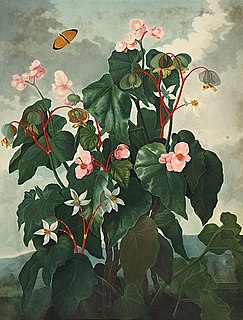
Begonia is a genus of perennial flowering plants in the family Begoniaceae. The genus contains more than 1,800 different plant species. The Begonias are native to moist subtropical and tropical climates. Some species are commonly grown indoors as ornamental houseplants in cooler climates. In cooler climates some species are cultivated outside in summertime for their bright colorful flowers, which have sepals but no petals.

Correa is a genus of eleven species of flowering plants in the family Rutaceae that are endemic to Australia. Plants in the genus Correa are shrubs to small trees with simple leaves arranged in opposite pairs, bisexual flowers with four sepals, four petals usually fused for most of their length and eight stamens.

Firs (Abies) are a genus of 48–56 species of evergreen coniferous trees in the family Pinaceae. They are found through much of North and Central America, Europe, Asia, and North Africa, occurring in mountains over most of the range. Firs are most closely related to the genus Cedrus (cedar). Douglas firs are not true firs, being of the genus Pseudotsuga.

The Crassulaceae, also known as the stonecrop family or the orpine family, are a diverse family of dicotyledon flowering plants characterized by succulent leaves and a unique form of photosynthesis, known as Crassulacean acid metabolism (CAM). Flowers generally have five floral parts. Crassulaceae are usually herbaceous but there are some subshrubs, and relatively few treelike or aquatic plants. Crassulaceae are a medium size monophyletic family in the core eudicots, among the order Saxifragales, whose diversity has made infrafamilial classification very difficult. The family includes approximately 1,400 species and 34–35 genera, depending on the circumscription of the genus Sedum, and distributed over three subfamilies. Members of the Crassulaceae are found worldwide, but mostly in the Northern Hemisphere and southern Africa, typically in dry and/or cold areas where water may be scarce, although a few are aquatic.
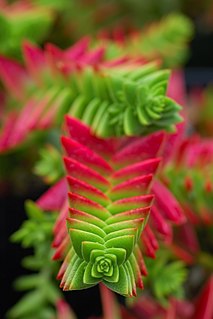
Crassula is a genus of succulent plants containing about 200 accepted species, including the popular jade plant. They are members of the stonecrop family (Crassulaceae) and are native to many parts of the globe, but cultivated varieties originate almost exclusively from species from the Eastern Cape of South Africa.

Crassula tetragona is a succulent plant native to Southern Africa. It is widely distributed from the Orange River boundary of Namaqualand to beyond the Kei River in the Eastern Cape. "Tetragona" comes from the phyllotaxy of the leaves. It is popularly named the "miniature pine tree" among ornamental plant enthusiasts, for its popular use as a "pine tree" in Bonsai.
Crassula colorata, the dense pigmyweed or dense stonecrop, is an annual plant in the family Crassulaceae. The species is endemic to Australia, occurring in Western Australia, South Australia, New South Wales and Victoria.
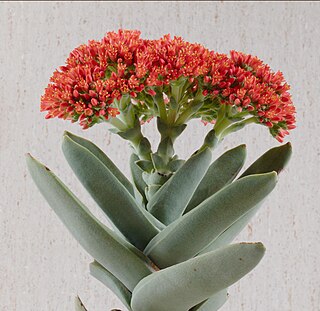
Crassula falcata, known by the common names airplane plant and propeller plant, is a succulent plant endemic to South Africa, from the Cape of Good Hope. The foliage is gray-green with striking texture, on plants that grow to 2 feet (0.61 m) tall. The flowers are tiny and scarlet red, that rise in dense clusters above the foliage for a month in summer. Crassula falcata is cultivated for use in drought tolerant and succulent gardens, and in container gardens.

Crassula muscosa, synonyms Crassula lycopodioides and Crassula pseudolycopodioides, is a succulent plant native to South Africa and Namibia, belonging to the family of Crassulaceae and to the genus Crassula. It is a houseplant grown worldwide and commonly known as rattail crassula, watch chain, lizard's tail, zipper plant and princess pines.

Crassula marnierana, common name Jade Necklace or Chinese Pagoda, is a species of succulent in the genus Crassula belonging to the family Crassulaceae.
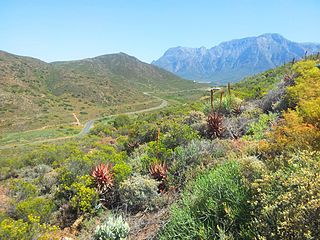
Robertson Karoo is a semi-arid vegetation type, restricted to sections of the Breede River Valley, Western Cape Province, South Africa. It is a subtype of Succulent Karoo and is characterised by the dominance of succulent plant species, and by several endemic plants and animals.

Crassula nudicaulis is a succulent plant native to South Africa, and Lesotho.
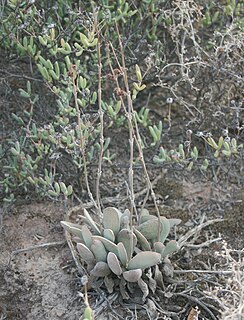
Crassula cotyledonis is a succulent plant endemic to the arid Namaqualand and Karoo regions of South Africa.
Crassula natans, commonly known as floating pigmyweed, is a herb in the family Crassulaceae.
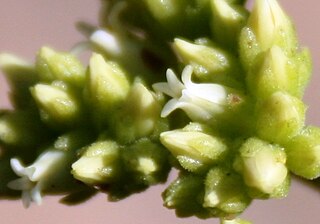
Crassula atropurpurea is a succulent plant, very common and widespread in the southern Karoo regions of South Africa and Namibia.

Crassula alpestris, also known as the sand-coated crassula, is a species of flowering plant in the genus Crassula found in South Africa. Crassula alpestris subsp. massonii is a variety of the species, also found in South Africa.

Crassula perfoliata is the type species of the nominative genus, Crassula, of the family Crassulaceae, where it is placed in the subfamily Crassuloideae. It was first formally described by Linnaeus in 1753 as one of 10 species of Crassula. It is a perennial, from S Africa.















